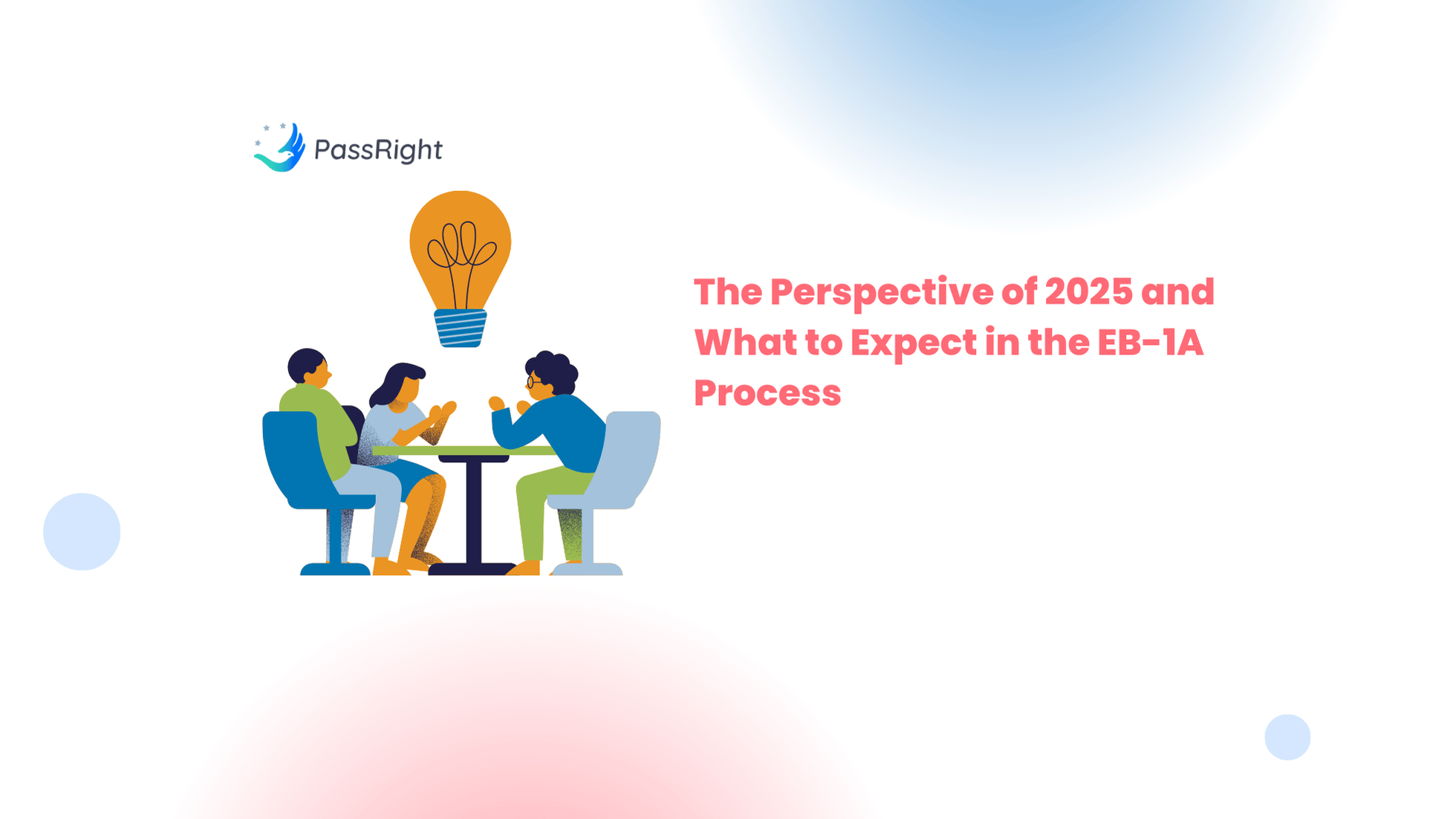The EB-1A visa is one of the most popular and sought-after immigration pathways for individuals with extraordinary abilities in their field. As 2025 begins, U.S. immigration policy continues to evolve and change, bringing new opportunities and challenges for applicants. While the future is uncertain, we can predict what will come in 2025 with recent updates and some strategies to enhance your EB-1A application.
This article offers valuable insights but should not be considered legal advice. For personalized guidance regarding your immigration situation, we recommend consulting an immigration attorney. If you’d like to speak with our lawyer, you can easily schedule a call with us.
Overview of the EB-1A Green Card
The EB-1A employment-based green card is a pathway for permanent residency in the United States for individuals with extraordinary ability in their fields, including the arts, sciences, education, business, and athletics. Different from other visa categories, the EB-1A does not require employer sponsorship, making this a popular choice for entrepreneurs.
To qualify for the EB-1A visa, the applicant must provide international or national recognition evidence. The criteria include:
- Receipt of a major international award (like the Nobel Prize or Olympic Medal)
If the applicant hasn’t received an internationally recognized award, they must meet at least three of the ten USCIS specified requirements, including:
- Published material about the applicant’s work in major media outlets
- Authorship of significant scholarly articles
- Proof of serving as a judge for others’ work
- Membership in associations that require outstanding achievement
- Any awards or honors for excellence in their field
- Show a high salary that is relative to others in their field
- Demonstrate leadership or critical roles in organizations
- Evidence of commercial success in the performing arts
- Provide any evidence of work displayed in artistic exhibitions or showcases
Given the strict requirements, the EB-1A has a high bar for approval, so careful preparation and consulting a legal expert are the keys to success.
Recent Policy Updates Impacting the EB-1A Visa Process
In the past few years, the USCIS has implemented several policy changes that have directly impacted EB-1A applicants. Some of the recent changes include:
Stricter EB-1A Evidence Standards
The USCIS has focused more on the qualifications and relevance of the evidence submitted to support an applicant’s extraordinary abilities. In general, meeting the required three of the ten criteria is no longer sufficient unless the evidence is comprehensive and well-documented to support extraordinary ability. It’s best practice to provide proof that meets more than three requirements.
Many changes were made to the requirements for the EB-1A eligibility criteria, which focused on expanding and clarifying the types of evidence that can support extraordinary ability petitions. Some of the recent changes include Team Awards Recognition – Team awards now qualify under nationally or internationally recognized prizes criterion. However, each team member must receive formal recognition through trophies, certificates, or medals.
Regional Adjudication Centers
The USCIS recently established regional adjudication centers for employment-based visas, resulting in a more streamlined review process for EB-1A petitions. However, this does not necessarily mean quicker processing times.
Key Updates in the February 2025 Visa Bulletin
The February Visa Bulletin maintains current filing dates for EB-1A applicants in most global regions, ensuring no delays for qualified applicants. A slight advancement is seen for EB-2 India priority dates, moving forward by two weeks.
For individuals tracking employment-based categories, this advancement highlights the importance of monitoring visa bulletin updates. Even small changes can significantly influence the timing of green card applications, especially for those considering switching categories or exploring additional options like the EB-1A for faster processing.
Expected Changes in the EB-1A Application Process for 2025
Each year brings different changes to visa policies, including the EB-1A visa. While we do not know for sure what’s to come, here are some of the anticipated changes for 2025:
Enhanced Use of AI for Adjudication
The USCIS has announced a plan to implement artificial intelligence tools to assist adjudicators in reviewing evidence, which will streamline the application process and lessen processing times. This announcement has raised concerns about how AI can evaluate subjective criteria effectively.
Updated Regulatory Guidance
There are anticipated policy updates in 2025 that may further define “extraordinary ability,” which may narrow or expand eligibility based on legislative priorities. Applicants should prepare their EB-1A applications with comprehensive documentation.
Increased Transparency
The USCIS has committed to improving the transparency of the adjudication process, which includes providing more detailed decision notices. This guides applicants on why specific evidence was accepted or rejected, leading to more clarity and less back and forth. These notices can give more context to any oversights or gaps in the EB-1A application.
EB-1 Processing Times and Visa Availability Predictions
The EB-1A visa category varies in processing times and can see changes in 2025.
Projected Processing Times
In 2025, EB-1A visa application processing times are expected to range from six to twelve months under regular processing. This means premium processing could reduce this timeline to 15 calendar days to hear a USCIS decision.
EB-1A Visa Availability
The EB-1A visa category is a strong option for applicants with extraordinary abilities. However, increased global interest in the EB-1A visa could strain annual caps. To ensure EB-1A visas are available, applicants should submit their petitions early in the fiscal year to avoid potential delays.
Strategies to Increase EB-1A Approval Rate in 2025
When preparing your EB-1A petition, think of it as telling a compelling story. Your evidence should highlight how your achievements have a measurable impact, with citations, media reach, and leadership roles clearly documented. To maximize your chances of EB-1A approval, follow these strategies:
- Build a Robust Portfolio: Include quantifiable evidence, such as citation counts, media reach, and measurable impact. For instance, a biotech researcher could highlight patents, major journal publications, and invitations to international conferences.
- Leverage Strong Recommendations: Secure letters from respected industry leaders who can vouch for your extraordinary abilities. These letters should explain how your work has had a significant impact in your field.
- Tailor Your Presentation: Structure your application to tell a clear story. For example, connect your evidence to the global significance of your work, making it easy for USCIS to see why you’re extraordinary.
- Plan for Processing Times: Regular processing can take six to twelve months, but premium processing guarantees a decision in just 15 calendar days. Use this option if time is critical.
- Address Potential Weaknesses
When reviewing your application before submission, look for any potential gaps and proactively address them. Keep in mind any metrics that the USCIS may use when reviewing your application and if the application is easy to follow. Having a second pair of eyes review the application can help see any potential weaknesses the USCIS may see. This can prevent any request for evidence (RFE) or denial reasons. - Stay Updated
The world of immigration is ever-changing, especially when a new presidential administration takes office. Applicants must monitor USCIS announcements and policy changes to stay ahead and ensure their applications align with the latest guidance. This can reduce back-and-forth with the USCIS and lead to a smoother EB-1A application process. - Consult Immigration Attorneys
Consulting expert legal representation to assist with EB-1A cases can provide invaluable guidance. The application process is constantly changing, so with a seasoned immigration attorney, you can stay ahead and have someone who can interpret any policy change impact on your EB-1A application. Immigration experts can answer any questions you have, guide any challenges, and respond to RFEs effectively and timely.
Conclusion
The EB-1A visa is a popular pathway for individuals with extraordinary abilities looking to secure permanent residency within the United States. As we progress through 2025, staying up-to-date about policy changes, adapting to new requirements, and strategic planning will be essential to success. By understanding some of the impending changes, applicants will be able to navigate through the immigration process effectively and with confidence.
FAQ
What recent policy updates have affected the EB-1A process?
Various USCIS policy updates impacted the EB-1A visa process, including stricter evidence requirements, inclusion of digital evidence, and involving stakeholders in visa evidence structures.How can applicants prepare for the EB-1A process changes in 2025?
EB-1A applicants can prepare for upcoming changes by building a very detailed and comprehensive portfolio that shows extraordinary abilities, staying up to date with any forthcoming immigration policy shifts, and consulting immigration attorneys.How are the EB-1A eligibility criteria expected to change in 2025?
The EB-1A eligibility requirements that are expected to change in 2025 are an increased emphasis on metrics in the application and a focus on interdisciplinary contributions.
Complete our free evaluation questionnaire to find out if you qualify for EB-1. Our attorneys and customer care team will guide you through your eligibility and the next steps.









